A UN - backed group helps small - scale miners in the Philippines find a safer alternative – often sodium cyanide.
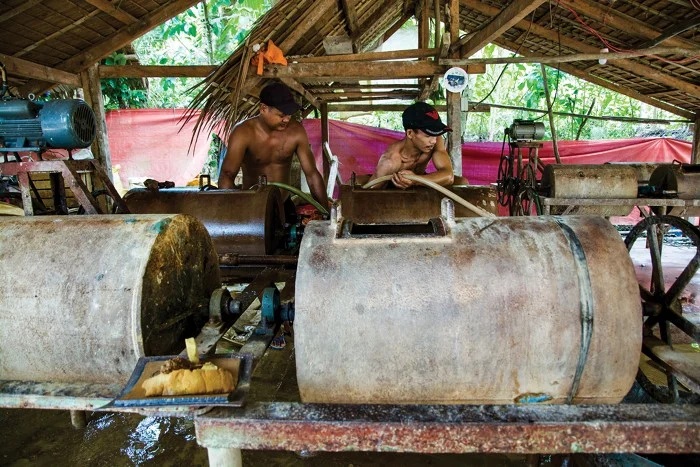
Workers process gold-containing ore at a small-scale plant in Paracale, the Philippines.
In the Philippines, as in many places across the globe, mercury has long been central to how small - scale gold miners earn their living. Used as an easy way to separate gold from other minerals they mine, the heavy metal is highly toxic and can cause neurological damage, defects in utero, and even death.
The Philippines outlawed mercury’s use in gold mining in 2012. Yet unregistered artisanal miners in the country continue to rely on the chemical for their day - to - day earnings. For them, a sense of denial prevails, despite learning about health hazards and even premature death experienced by people working in the sector.
A mine owner and lender to miners operates a small facility that excavates ore from shafts dug deep below the property and processes it in grinding mills. A few spoonfuls of mercury are tipped in every time the mills are fired up.
Artisanal miners use mercury because it is simple. When mercury is mixed with ore, it binds with the gold, creating an amalgam of roughly equal parts of the two metals. The mercury is then typically burned off, leaving behind gold but also creating a toxic vapor that many miners inadvertently inhale.
The mine owner says about using mercury to support the family, explaining that a shaft had to be closed and a new tunnel invested in after a cyclone caused flooding.
Mercury - contaminated water is everywhere at the site, including in a small pool where miners use the toxic substance to pan for gold in ore that is diverted from the mill. The pool is surrounded by sandbags and sits just meters away from a river where young children fish.
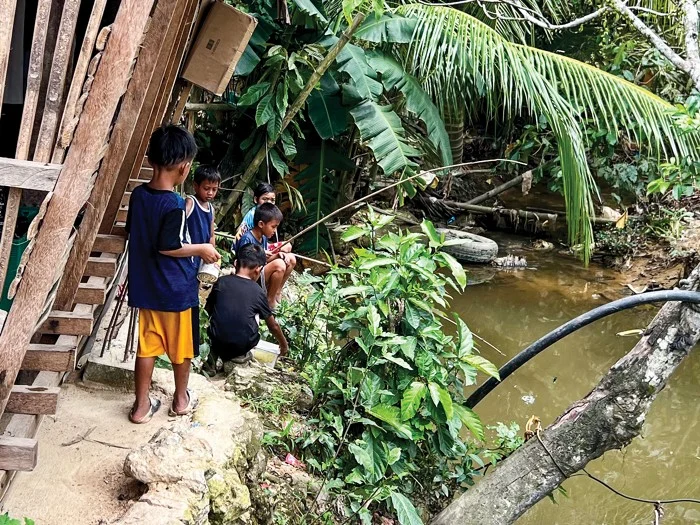
Children fish next to a small gold mine in Paracale, the Philippines, that continues to use mercury in its extraction process.
The owner admits that mercury is very dangerous. There are roughly a dozen men working at different stations in the complex, and another 10 are busy extracting ore underfoot. Workers are told not to use it if they have scars, to avoid absorption into the bloodstream.
The visit to the plant is part of a press trip organized by a United Nations–led program, planetGOLD, that works to help small - scale gold miners comply with the treaty, the Minamata Convention on Mercury. Reporters visited mines and processing plants that are at various stages of a transition away from mercury.
It was clear from the visits that a transition will happen only if miners become more aware of risks and get help from authorities to find viable alternative methods of extracting gold. For now, many miners are finding a solution in another dangerous chemical: Sodium Cyanide.
Encouraging Change
Ever since Spanish colonists began searching for gold in the Philippines in the late 16th century, poor artisanal miners have been drawn to the industry, particularly during surges in the price of gold. People around a certain area have worked all their lives in the sector. In 2020. someone inherited a mine.
As global uncertainty drives investors toward safe - haven assets and the energy transition increases the demand for gold and other minerals, gold prices have risen—by roughly 10% in 2024 alone—drawing more people to this line of work.
The UN estimates that 15 million people—including 4 million–5 million children and women—are employed in over 80 countries in small - scale mining operations that yield roughly 20% of the world’s output of the metal. Providing a source of income for people in remote areas where few other options exist, this artisanal gold mining releases some 2.000 metric tons (t) of mercury annually into the environment.
Since the Minamata Convention entered into force 7 years ago, planetGOLD has been working with authorities, miners, financiers, and local communities to change the way gold is extracted and processed. Efforts include building awareness of mercury’s risks while helping to adapt mercury - free mining and processing methods to local needs. Individual planetGold programs typically last 5 years, after which efforts are continued by communities and local authorities.
planetGOLD has operated in over 20 countries in Africa, Asia, and Latin America. In the program’s 2022–23 annual report, analysts estimated that its efforts had to date prevented the use of 31.4 t of mercury in six of the countries where it operates. In several countries, including Colombia, Peru, and Burkina Faso, planetGOLD encourages local financial organizations to provide credit to miners to help them adopt mercury - free processing technologies.
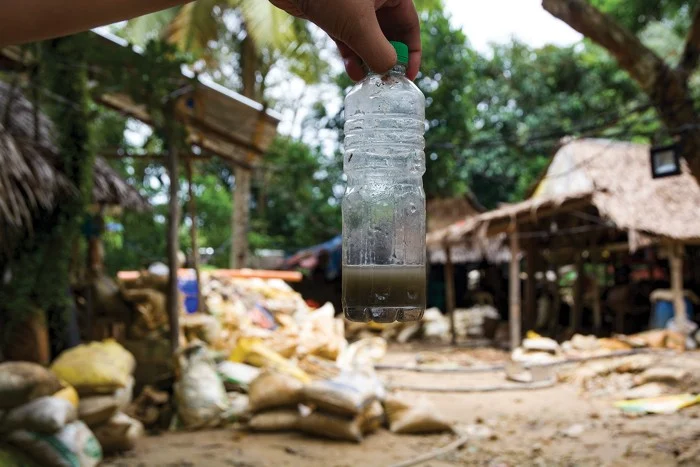
A plastic bottle holds mercury at a small-scale gold mine and processing plant in Paracale, the Philippines.
In a certain place in the Philippines where planetGOLD is present, a $500.000 mercury - free processing plant awaits official certification to begin operations in early 2025. when ownership will be transferred to miners and planetGOLD will retreat. Built on a hill above the town to take advantage of gravity in separating and milling of the ore, it will assist members of the local miners association, which goes by the acronym SMBC.
In gold cyanidation, regularly used in large - scale mining, miners create a slurry of crushed ore and water and add sodium cyanide, which dissolves the gold. Activated carbon is added, acting as a sponge to soak up the gold - cyanide complex. The gold - laden carbon particles, which are larger than the bits of ore, are then separated using a wire mesh. Gold is recovered with the addition of more cyanide or via smelting.
Unlike mercury, which persists in the environment, the cyanide can be detoxified through oxidation with hydrogen peroxide or sodium metabisulfite.
Disclaimer
This article is reposted from the Internet. The content is for reference only, and we do not claim any ownership or original creation of it. We are not responsible for the accuracy, completeness, timeliness, or reliability of the information in the article. If there are any issues regarding copyright or other legal concerns, please contact us, and we will take appropriate actions promptly.
- Random Content
- Hot content
- Hot review content
- ENVIRONMENTAL MANAGEMENTSYSTEM CERTIFICATE
- Flexible Customer and Supplier Relations Specialist (Location: India)
- Plastic Shock Tube(VOD≧1600m/s)
- Featured Poducts Sodium Cyanide
- Toluene
- Dodecylbenzenesulfonic acid
- Hydrogen Peroxide
- 1Discounted Sodium Cyanide (CAS: 143-33-9) for Mining - High Quality & Competitive Pricing
- 2China's New Regulations on Sodium Cyanide Exports and Guidance for International Buyers
- 3Sodium Cyanide 98% CAS 143-33-9 gold dressing agent Essential for Mining and Chemical Industries
- 4International Cyanide(Sodium cyanide) Management Code - Gold Mine Acceptance Standards
- 5China factory Sulfuric Acid 98%
- 6Anhydrous Oxalic acid 99.6% Industrial Grade
- 7Oxalic acid for mining 99.6%
- 1Sodium Cyanide 98% CAS 143-33-9 gold dressing agent Essential for Mining and Chemical Industries
- 2High Quality 99% Purity of Cyanuric chloride ISO 9001:2005 REACH Verified Producer
- 3Zinc chloride ZnCl2 for High Molecular Weight Polymers Initiator
- 4High Purity · Stable Performance · Higher Recovery — sodium cyanide for modern gold leaching
- 5High Quality Sodium Ferrocyanide / Sodium Hexacyanoferr
- 6Gold Ore Dressing Agent Safe Gold Extracting Agent Replace Sodium Cyanide
- 7Sodium Cyanide 98%+ CAS 143-33-9



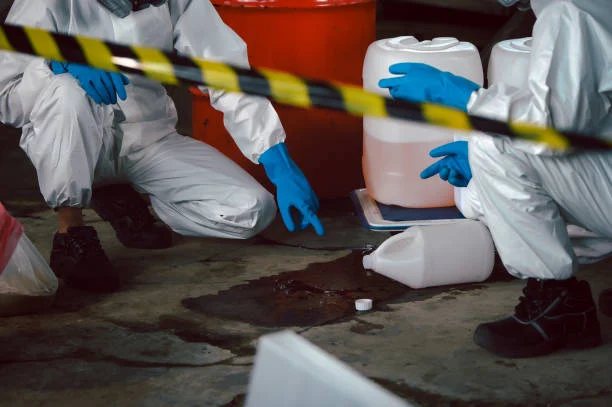
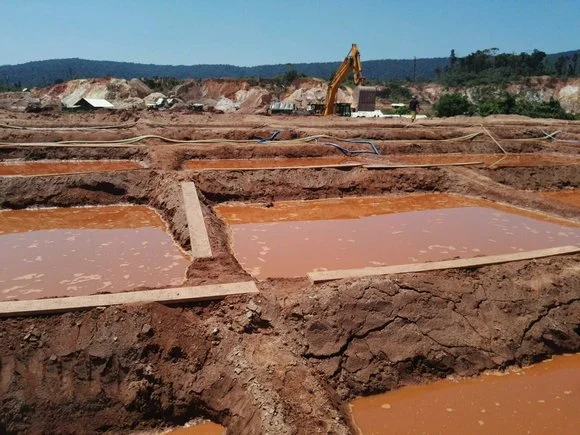

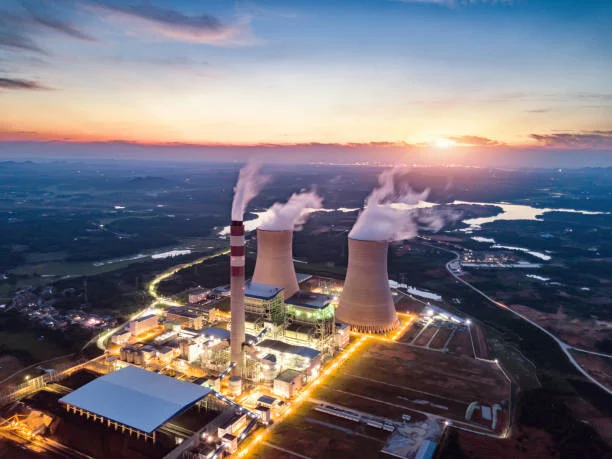

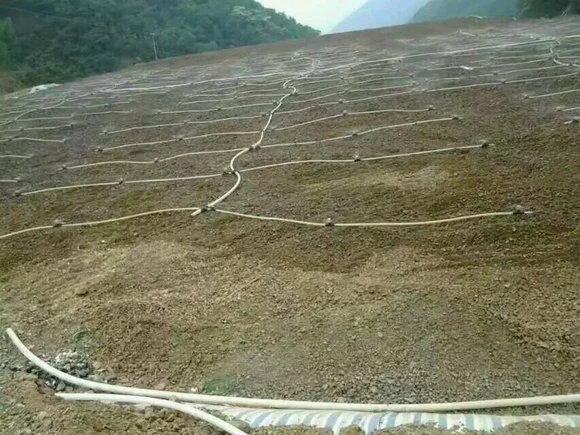


Online message consultation
Add comment: